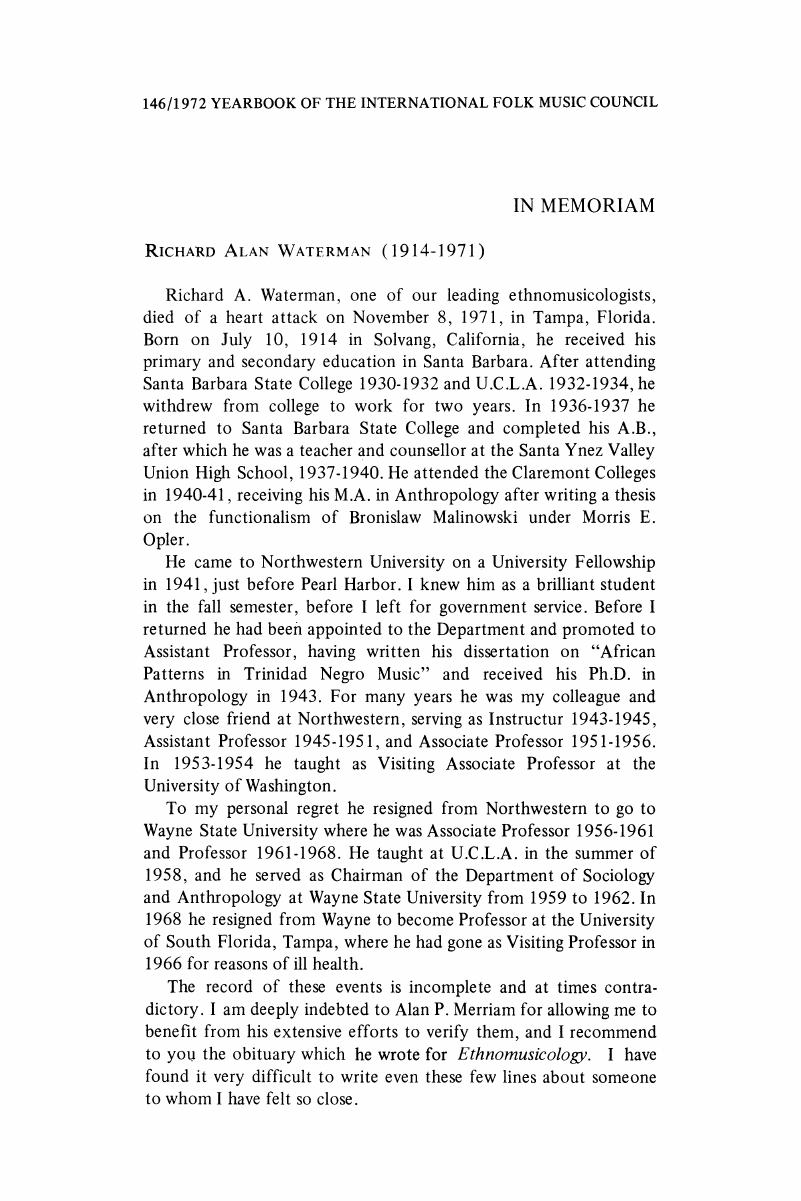No CrossRef data available.
Article contents
Richard Alan Waterman (1914-1971)
Published online by Cambridge University Press: 14 February 2019
Abstract
An abstract is not available for this content so a preview has been provided. As you have access to this content, a full PDF is available via the ‘Save PDF’ action button.

- Type
- Obituary
- Information
- Copyright
- Copyright © 1973 By the International Folk Music Council
References
Bibliography: A Selection
(For a more complete bibliography of Dr. Waterman's work by Gillis, Frank J. and Merriam, Alan P.
see Vol. 17, No. 1, January, 1973 of Ethnomusicology.)Google Scholar
“African Patterns in Trinidad Music.” Summaries of Doctoral Dissertations. (Chicago and Evanston: Northwestern University), 11(1944), 57–61.Google Scholar
“Percussion and Rhythms in the Music of the Negroes of Trinidad (abstract).” Chicago Anthropological Society Bulletin
1, Nos. 3–4 (1945), 7–8.Google Scholar
Folk Music of Puerto Rico. Recorded and edited, with descriptive notes and texts. Originally issued in five 10” 78 rpm. discs by Archive of American Folk Song, Library of Congress, 1947. Reissued as one 12” 33 1/3 rpm. AFSL 18 in 1955.Google Scholar
“Survey of Recordings of Asiatic Music in the United States, 1950–51,” Notes
8(Sept. 1951), 683–691.Google Scholar
“Hot Rhythm in Negro Music,” Journal of the American Musicological Society
1, No. 1 (Spring 1948), 24–37.Google Scholar
“African and New World Folklore,” (with Bascom, William R.), Standard Dictionary of Folklore, Mythology and Legend, Maria Leach, ed. (New York, 1948), 18–24.Google Scholar
“Musico de culto Afrobahiana,” (with Herskovits, Melville J.), Revista de Estudios Musicales (Mendoza, Argentina), 1 (1948), 65–127.Google Scholar
“The Role of Obscenity in the Folk Tales of the ‘Intellectual’ Stratum of Our Society,” Journal of American Folklore
62(1948), 162–165.Google Scholar
Articles in Collier's Encyclopedia (New York, 1950, 1958, 1965): “Arabic music,” vol. 2 (1950, 1958), 96; vol. 17(1965), 44. “Chinese Music,” 5(1950, 1958), 206–207; 17(1965), 45–46. “Hindu Music,” 10(1950, 1958), 70–71; 17(1965), 44–45. “Japanese music,” 11(1950, 1958)’ 353–354. “Negro,” 14(1950), 460–462; in 1958 ed. article changed to “Negro Ethnology.”Google Scholar
“Laboratory Notes on Tribal Folk and Cafe Music of West Africa,” in Text and Commentaries to Tribal Folk and Cafe Music of West Africa, pp. 5–11. See: “Field Recordings of African Coast Rhythm,” Riverside Records, RLP 4001 (1953), and “Field Recordings of New Songs of the African Coast,” Riverside Records, RLP 4003 (1954).Google Scholar
“African Influence on the Music of the Americas,” Acculturation in the Americas, Sol Tax, ed. Proc. and Selected Papers of the 29th International Congress of Americanists, 2(1952), 207–218.Google Scholar
“The Chicago Seminar” (with Hayakawa, S.I., Turner, Lorenzo, and Menmm, Alan P.), Record Changer
12(July-August 1953), 14–17, 48.Google Scholar
“Ethnological and Ethnomusicological Field Investigation of the Aboriginals of Yirkala, Northeastern Arnhem Land, Australia.” Yearbook of the American Philosophical Society, (1953), 176–179.Google Scholar
“Music,” in Handbook of Latin American Studies, 17(1954), 220–224; 18(1955), 236–242; 19(1957), 310–316; 20(1958), 288–290.Google Scholar
Theory of Classical Hindustani Music. Directed and edited, with 8pp. introduction. 12” 33 1/3 rpm. Folkways Record FM8366 (1955).Google Scholar
“The Moral Values of the Aboriginals of Yirkalla in Northeast Arnhem Land, Australia,” Encyclopedia of Morals, Ferm, Vergilius T.A., ed. (New York, 1956), 1–8.Google Scholar
“Music in Australian Aboriginal Culture – Some Sociological and Psychological Implications,” Music Therapy,
Gaston, E. Thayer, ed. Proc. National Assoc. for Music Therapy 5(1956), 40–49.Google Scholar
“African Negro Art and Music,” American People's Encyclopedia (Chicago) 14(1958), cols. 160,163.Google Scholar
“Role of Dance in Human Society,” Focus on Dance, Wooten, Bettie Jane, ed., 2(1962), 47–55. (An Interdisciplinary Search for Meaning in Movement, Wash., D.C.)Google Scholar
“On Flogging a Dead Horse: Lessons Learned from the Africanisms Controversy.” Ethnomusicology
7(1963), 83–87.Google Scholar
“Aboriginal Songs from Groote Eylandt, Australia.” Proc. Centennial Workshop on Ethnomusicology (University of British Columbia, Vancouver; Government of the Province of British Columbia, 1968), 102–113.Google Scholar
“Local Group Composition Among Australian Aborigines; A Critique of the Evidence from Fieldwork Conducted since 1930.” Current Anthropology, 11, No. 2 (April 1970), 137. (Comments on Birdsell's article).Google Scholar
Diprodoton to Detribalization: Studies of Change Among Australian Aborigines, co-editor with Arnold R. Pilling. East Lansing: Michigan State University Press, 1970. xiv, 418 pp.Google Scholar
“Directions of Culture Change in Aboriginal Arnhem,” (with Patricia Panyity Waterman), in Diprotodon to Detribalization … pp. 101–109.Google Scholar
“African Influence with the Blues: An Interview with Richard A. Waterman,” by Summers, Lynn S.
Living Blues (Chicago), 6(Autumn 1971), 30–36.Google Scholar


